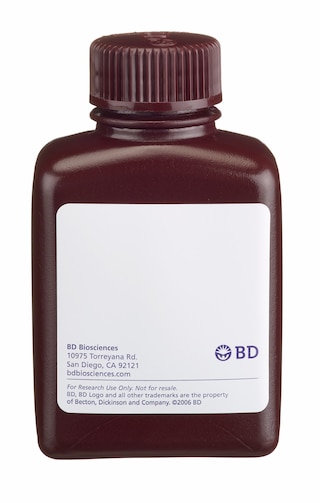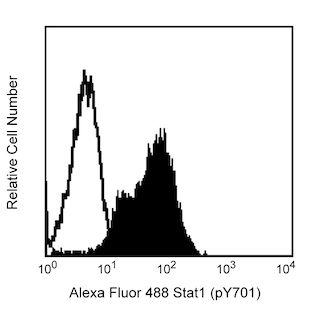Old Browser
This page has been recently translated and is available in French now.
Looks like you're visiting us from {countryName}.
Would you like to stay on the current country site or be switched to your country?




Flow cytometric analysis of phosphorylated ZAP70 expression by treated Jurkat cells. Jurkat cells (ATCC TIB 152) were serum-starved overnight in RPMI-1640 tissue culture medium containing 0.1% fetal bovine serum. The following day, cells were either left untreated (dashed line histogram) or treated (solid line histogram) with hydrogen peroxide (H2O2; 5 mM for 15 minutes at 37°C). The cells were fixed with BD Cytofix™ Fixation Buffer (Cat. No. 554655) for 10-15 minutes at 37ºC, then permeabilized (BD Phosflow™ Perm Buffer III, Cat. No. 558050) on ice for at least 30 minutes, washed and then stained with PerCP-Cy™5.5 Mouse Anti-ZAP70 (pY319)/Syk (Y352) antibody (Cat. No. 561459). The fluorescence histograms were derived from events with the forward and side light-scatter characteristics of intact Jurkat cells. Flow cytometry was performed using a BD™ LSR II Flow Cytometer System.


BD™ Phosflow PerCP-Cy™5.5 Mouse Anti-ZAP70 (pY319)/Syk (Y352)

Regulatory Status Legend
Any use of products other than the permitted use without the express written authorization of Becton, Dickinson and Company is strictly prohibited.
Preparation And Storage
Product Notices
- This reagent has been pre-diluted for use at the recommended Volume per Test. We typically use 1 × 10^6 cells in a 100-µl experimental sample (a test).
- An isotype control should be used at the same concentration as the antibody of interest.
- PerCP-Cy5.5 is optimized for use with a single argon ion laser emitting 488-nm light. Because of the broad absorption spectrum of the tandem fluorochrome, extra care must be taken when using dual-laser cytometers, which may directly excite both PerCP and Cy5.5™. We recommend the use of cross-beam compensation during data acquisition or software compensation during data analysis.
- Please observe the following precautions: Absorption of visible light can significantly alter the energy transfer occurring in any tandem fluorochrome conjugate; therefore, we recommend that special precautions be taken (such as wrapping vials, tubes, or racks in aluminum foil) to prevent exposure of conjugated reagents, including cells stained with those reagents, to room illumination.
- Cy is a trademark of Amersham Biosciences Limited. This conjugated product is sold under license to the following patents: US Patent Nos. 5,486,616; 5,569,587; 5,569,766; 5,627,027.
- This product is subject to proprietary rights of Amersham Biosciences Corp. and Carnegie Mellon University and made and sold under license from Amersham Biosciences Corp. This product is licensed for sale only for research. It is not licensed for any other use. If you require a commercial license to use this product and do not have one return this material, unopened to BD Biosciences, 10975 Torreyana Rd, San Diego, CA 92121 and any money paid for the material will be refunded.
- Source of all serum proteins is from USDA inspected abattoirs located in the United States.
- Caution: Sodium azide yields highly toxic hydrazoic acid under acidic conditions. Dilute azide compounds in running water before discarding to avoid accumulation of potentially explosive deposits in plumbing.
- For fluorochrome spectra and suitable instrument settings, please refer to our Multicolor Flow Cytometry web page at www.bdbiosciences.com/colors.
- Please refer to www.bdbiosciences.com/us/s/resources for technical protocols.
Companion Products



ZAP70 is a protein tyrosine kinase (PTK) that associates with the z subunit of the T cell antigen receptor (TCR) and undergoes tyrosine phosphorylation following TCR stimulation. ZAP70 contains two SH2-like domains with the PTK domain located at the C-terminus. It appears that both ZAP70 and Syk are recruited to the phosphorylated CD3 and z subunits after TCR stimulation. TCR stimulation leads to autophosphorylation of ZAP70 at Tyr-315 amd Tyr-319, and mutation of the Tyr-319 site dramatically impairs TCR signaling. In addition, TCR-mediated Lck activity leads to phosphorylation of ZAP70 on Tyr-493 in the regulatory loop of the kinase domain leading to upregulation of ZAP70 kinase activity. The significance of ZAP70 activation in mediating TCR signal transduction has been confirmed by showing that ZAP70 activity is absent in an autosomal recessive form of severe combined immunodeficiency (SCID). This is due to mutations affecting the ZAP70 kinase domain which affect the stability of the protein and TCR signaling.
Clone 17A/P-ZAP70 recognizes the phosphorylated form of ZAP70 (Y319). It also cross-reacts with SYK (Y352) due to homology of the phosphorylation site with ZAP70 (Y319). The PE-conjugated format has been evaluated using human and mouse model systems. The unconjugated form of the antibody (Cat. No. 612574) has also been shown to work in western blot analysis on human, mouse, and rat cells.

Development References (3)
-
Arpaia E, Shahar M, Dadi H, Cohen A, Roifman CM. Defective T cell receptor signaling and CD8+ thymic selection in humans lacking zap-70 kinase. Cell. 1994; 76(5):947-958. (Biology). View Reference
-
Chan AC, Kadlecek TA, Elder ME, et al. ZAP-70 deficiency in an autosomal recessive form of severe combined immunodeficiency. Science. 1994; 264:1599-1601. (Biology).
-
Di Bartolo V, Mege D, Germain V, et al. Tyrosine 319, a newly identified phosphorylation site of ZAP-70, plays a critical role in T cell antigen receptor signaling. J Biol Chem. 1999; 274(10):6285-6294. (Biology). View Reference
Please refer to Support Documents for Quality Certificates
Global - Refer to manufacturer's instructions for use and related User Manuals and Technical data sheets before using this products as described
Comparisons, where applicable, are made against older BD Technology, manual methods or are general performance claims. Comparisons are not made against non-BD technologies, unless otherwise noted.
For Research Use Only. Not for use in diagnostic or therapeutic procedures.
Report a Site Issue
This form is intended to help us improve our website experience. For other support, please visit our Contact Us page.